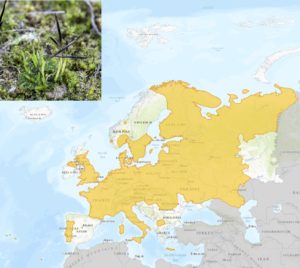We live grim times and our lives have been deeply impacted by the COVID-19. However, we continue to do research, and our remote work (télétravail in French), publishing two articles on our most dear group of plants: the hornworts.
Hornworts are probably the most overlooked of all plant groups. In the last weeks, three important papers have been published focused on hornworts.
The first paper published by a group of talented Chinese colleagues described the nuclear genome of a dioicous hornwort, Anthoceros angustus.
Additionally, the Villarreal lab is part of an international team that has published the nuclear genome of the model species Anthoceros agrestis and Anthoceros punctatus. The research is led by Fay-Wei Li and Peter Szövényi and you can find the paper in a recent volume of Nature Plants.

Both species (A. agrestis and A. punctatus) are widespread in the world and they have subject on intense research for decades, starting with Johannes Max Proskauer, a German-born scientist that explored all aspects of the biology of these species and hornworts in general. After Proskauer’s tragic death in 1970, hornworts were neglected for nearly 10 years until a bright PhD student, Karen Renzaglia (Southern Illinois University, Carbondale), published a seminal paper on the anatomy and development of hornworts. Then, Karen launched a spectacular career working on hornworts, other bryophytes and ferns. In the year 2003, Karen spearheaded (and very few other colleagues around the world, literally 4 ! and JCVA as a graduate student) a NSF-funded grant to study the systematics and evolution of hornworts.
Since then, hornworts have garnered attention and they have been at the centre of the debate of the evolution of land plants. The paper by Li et al., explored the biology of this fascinating group of plants and use fancy genomic tools to understand the myriad of morphological and genomic traits of hornworts such as their distinct sporophyte architecture, cyanobacterial symbiosis, rampant RNA editing and a pyrenoid-based carbon-concentrating mechanism. The latest genomic paper highlights the importance of the group and it shows how far we have come, from four lonely scientists to one (or two) consortium of thirty-five researchers from at least ten countries!
Then, this week we have published an article on the phylogenetic relationships and origin of the model species A. agrestis. The study led by T. Dawes and L. Forrest resolved a lineage of genetically near-uniform European A. agrestis accessions and two non-European A. agrestis lineages. In addition, the cosmopolitan species Anthoceros punctatus forms two lineages, one of mostly European accessions, and another from India. All studied European A. agrestis accessions have a single origin, radiated relatively recently (less than 1 million years ago), and are currently strictly associated with agroecosystem habitats.
These studies prompt a number of questions on symbiosis, stomata evolution, carbon concentrating mechanism, genome streamlining, RNA editing, etc.. Hornworts with their haploid dominant life cycle may become the new “hot” model system in evolutionary biology.
Stay tuned!